SIRMIONE, LAKE GARDA—HOME TO A MOATED CASTLE AND AN ENORMOUS ROMAN VILLA
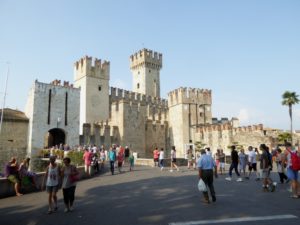
‘The pearl of islands!’ wrote the Roman poet Catullus in the 1st century BCE, describing the town of Sirmione, on the southern shore of beautiful Lake Garda in northern Italy. Less than 40 kms from Verona and 150 kms from Venice, Lake Garda is ideally placed to visit one of the loveliest parts of northern Italy.
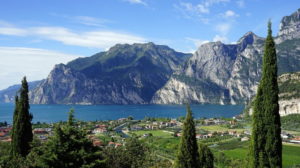
Lake Garda is the largest lake in Italy, but of the big three—the other two being Como and Maggiore—Garda is probably the least visited.
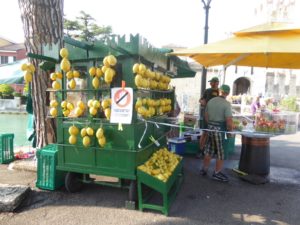
Known for its crystal clear water, it’s on the edge of theDolomites with its northern reaches surrounded by mountains. Given its predominantly alpine location, it’s something of a surprise to discover that Garda has a particularly mild climate which is ideal for many Mediterranean plants, including lemon and olive trees.
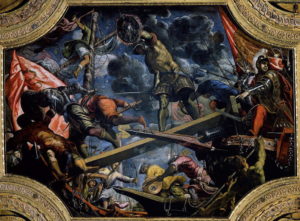
A number of locations along the lake have had a turbulent past. Roman legions defeated local tribes inhabiting the lake shores in the 3rd century BCE; In 1438 a major battle between Milan and the Venetian Republic took place, following an extraordinary military feat whereby a number of Venetian ships were transported from the Adriatic Sea to Lake Garda. This operation consisted of navigating the river Adige and then taking the vessels overland to Torbole on the northern shore of the lake, a journey of about 20 kms. The lake was also the site of a number of naval battles in the mid 19th century between Italy and Austria.

Lake Garda’s most recent claim to fame (or notoriety) was that Benito Mussolini, in his last stand as Il Duce, established the capital of his diminished Italian Social Republic, the Salò Republic, in 1943 in the town of Gargnano near Salò on the shores of the lake. Mussolini was effectively under house arrest at his private residence, the Villa Feltrinelli, since he was surrounded by 30 elite SS guards, a number of gun emplacements were erected and a bomb shelter dug in the garden. The villa is now a summer study centre of the University of Milan. As the Allies got closer, Mussolini and his mistress Claretta Petacci went into hiding in nearby Gardone Riviera at the Villa Fiordaliso, now a beautiful Relais & Chateaux boutique hotel. The couple were captured and executed by partisans in the town of Mezzegra on Lake Como.
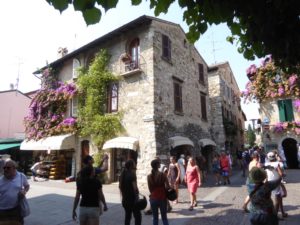
At the end of a long promontory at the southern end of Lake Garda lies the ancient fortified town of Sirmione, one of the loveliest and most interesting of the resort towns dotted around the lake. It’s hard to imagine a more picturesque entrance to a town: across a moat on a drawbridge and into the forecourt of the 12th century castle built by the Scaligeri, Verona’s ruling family, as part of their defensive network against Milan. Nowadays, visitors can tour the restored interior and it’s possible to climb the tower to enjoy panoramic views of the lake and town.
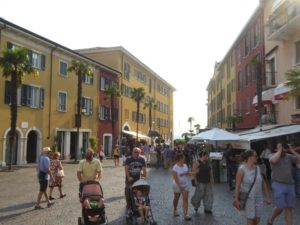
Long before the Scaligeri, well-heeled Romans came here to bathe in the sulphur springs—now the location of a luxurious spa and hotel. The tiny, narrow streets are lined with more gelaterie than we’ve ever seen in one place, as well as numerous smart little boutiques, ristorante, bars and cafes.
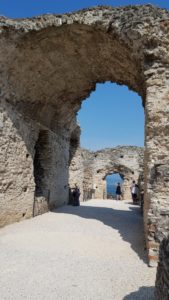
Aside from the Castello, the main claim to fame for Sirmione—apart from its beautiful location—is the archaeological site known as the Grottoes of Catullus. This is something of misnomer, as it’s neither a grotto, and it’s certain that the Roman poet Catullus never lived there (despite what most of the tourist blurbs say). Although it is known that his wealthy family did have villa at Sirmione, this particular villa was constructed in the early 1st century CE, well after the time of Catullus.
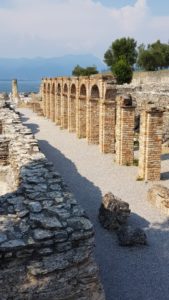
The finer points of historical accuracy are really irrelevant to the enjoyment of visiting the ruins of this vast Roman villa complex, which occupies a prime site at the end of the peninsula. Napoleon ordered the first excavations and studies of the villa, although reconstruction and restoration works didn’t commence until around 1940.

Still an active archaeological site, there is so much more to see nowadays than our first visit many years ago. There is reasonably good signage explaining the layout of the villa as you traverse the site, and visitors are free to walk around and through the various rooms and buildings of the villa, many of which were three stories high. There are wonderful views over the promontory and the small beach below.

If you’re driving, it’s no longer permitted to take private vehicles inside the walled town. There is now a community carpark just on the edge of town where everyone parks their car for the duration of their stay, and you are shuttled by car or golf buggy to and from your hotel. The parking fee is pre-paid with your hotel reservation, and a voucher is emailed to you with an access code for the carpark. It’s an efficient and very necessary system, obviously brought about through overcrowding and the near-impossibility of finding a parking place inside the tiny town.
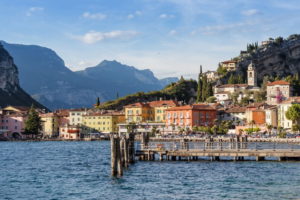
Once you’ve settled into your hotel, you won’t need a car since you’ll either be on foot exploring the town, the Grottoes of Catullus and the small beach, or taking a leisurely cruise on the local ferry around this beautiful lake.



What a scenic area! The mixture of mountains and lake are irresistible, and the villa (whoever it belonged to) adds that touch of antiquity that emphasises the many layers of history, and the inhabitants who went before. I do wonder where the so-called bust of Catullus came from. I don ‘t recall that there were any in existence but, as they say, don’t let the truth get in the way of a good story!
Salve Lois!
You and I know very well about the “inconvenient truth” about Catullus. When you think of the hours we put in translating the great man’s work for our Latin assignments, and reading all about his wicked tongue… You’re quite right about the bust in the park near the ferry wharf. Whenever I’ve been past it, I’ve always wondered upon what authority the artist executed the “likeness”!! As you say, never let truth get in the way of a good story. I’m sure Gaius Lucilius Catullus would be thrilled that we’re talking about him!
Cheers, Cheryl